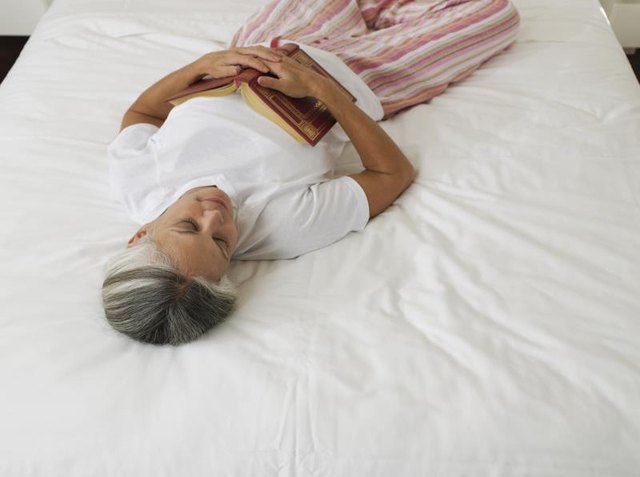
Sleeping positions vary from person to person, and sometimes from night to night. According to the U.K. Sleep Assessment and Advisory Service, the majority of people sleep on their sides. Some sleep positions are healthier than others for your back, and researchers say that sleep positions can indicate personality traits.
Side Sleeping in a Fetal Position
According to the U.K. Sleep Assessment and Advisory Service, which conducted a survey of 1,000 people, approximately 41 percent sleep on their sides in a fetal position. Women are twice as likely as men to sleep this way, according to the results, and fetal side sleepers tend to be tough but sensitive, according to the survey results. According to television physician Dr. Mehmet Oz, sleeping on your side in a fetal position is the healthiest position for sleep because it complements the spine's natural curve. If you’re a side sleeper who suffers from back pain, hip pain or spine osteoarthritis, pull your legs toward your chest, and sleep with a pillow between your legs, advises the Mayo Clinic.
Side Sleeping With Arms By Side
This is the second-most common sleep position, according to the study. Fifteen percent of people sleep in this position. Researchers found that survey respondents who slept in this position were easy-going and trusting.
Side Sleeping With Arms Extended
Thirteen percent of people surveyed sleep on their sides with their arms in front of them. Researchers say that people who sleep in this position tend to be open, are slow to make decisions but are steadfast in their decisions once they are made.
Back Sleeping with Arms at Sides
Eight percent of people sleep this way, according to the survey. They tend to be quiet and reserved, according to the results. Back sleeping makes snoring more likely, according to the study’s lead researcher, Chris Idzikowski, director of the Sleep Assessment and Advisory Service. This might be because sleeping on your back makes it easier for your tongue to fall into a position that blocks the breathing tube, according to Oz. Infants should always sleep on their backs to reduce the likelihood of Sudden Infant Death Syndrome, or SIDS, says Oz, but those with heart failure, respiratory diseases or gastroesophogeal reflux disease should avoid this position. If you’re a back sleeper with lower back pain, placing a pillow under your knees might help, according to the Mayo Clinic.
Stomach Sleeping with Arms Around Pillow
Seven percent of people sleep on their bellies, with their heads turned to the side. According to the service, they tend to be outgoing and brash, but they don’t like criticism. This position, according to Idzikowski, is best for digestion. But according to Oz, stomach sleeping compresses the lungs—meaning that you won’t breathe as fully—and puts pressure on the breasts.
Back Sleeping with Both Arms Around Pillow
Five percent of people sleep this way, the study found. The survey indicates that these back sleepers are good listeners and tend to be helpful.





No comments:
Post a Comment